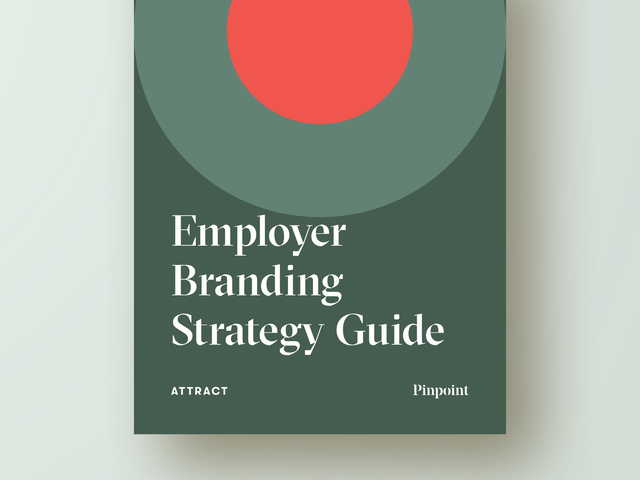In my decade-long talent acquisition career, one of the most challenging missions was leading recruiting (as a team of one) for a management consulting firm. Our clients were Fortune 100 companies, mostly in the aerospace and defense industries, seeking guidance on significant business decisions (such as acquisitions, entering new markets, future product innovations, and competitor analyses).
Clients expected our work to be done by some of the brightest young minds in the country, including recent graduates of the Ivy League and top tier universities. We needed to hire from this narrow talent pool both for the skills they had gained during their exceptional educational experiences and for the legitimacy it brought to the company brand.
Our main recruiting goal was to successfully compete for talent against big name consulting firms during seasonal campus recruiting at top tier schools across the U.S. We were an unknown entity compared to our competitors who could offer more prestige and a stronger brand name on candidates’ resumes.
Despite a crowded recruiting space and a very high bar for talent, we needed to hire 15-20 recent grads each year in order to meet the demands for client work. It was not an easy task. But by developing a strong Employee Value Proposition, we were able to attract more competitive talent year-over-year.
If you find yourself facing your own recruiting challenge, I hope I can be helpful by sharing my story and some examples from brands I admire.
An authentic EVP
While I couldn’t control the size of my team or the amount of resources behind me, I could achieve outsized goals with an authentic Employee Value Proposition.
In a world where most careers pages and job descriptions are filled with generic, vague, overly-corporate verbiage, I found it relatively easy to stand out with messaging that was precisely calibrated to the company’s unique offerings in the talent market. The key was to have an EVP that I, and my colleagues, actually believed was true.
With help from many conversations with employees, we identified differentiators that were both accurate and meaningful to our target audience of current seniors at top tier colleges. We created the core concepts of our EVP based on what we could guarantee that the big name consulting firms could not:
- Interesting project topics/industries: At big name firms, the chance of getting assigned to a boring topic or industry was purely luck of the draw and out of your control. Yet, at our firm, we only worked in specific industries that tended to be more appealing to candidates.
- Engaging, challenging analyses on projects: Similarly, big firms could assign you to a minute or boring aspect of a project as a new employee without much influence or prior reputation. Our project structure gave analysts substantial responsibilities from day one.
- Exposure to C-suite level clients immediately: At big name firms, it’s usually only the managers or directors who interact directly with clients, but it was common for us to have entry-level analysts join their team in presenting work in person, including with executive level clients.
- Highly collaborative, supportive culture: Big name firms tended to operate from an “up or out” promotion practice where lower level employees are competing against each other for a limited number of opportunities to stay and grow at the firm. We were able to create a more team-oriented culture and promote everyone who did well with us.
As we incorporated these core concepts into our employer branding and recruitment marketing, we experienced a wave of positive feedback that validated we were going in the right direction. The numbers of applications we received and the number of candidates making it to the final interview stage increased year over year from that point on. While our standards remained high (only hiring 1-2% of applicants), we were able to exceed our hiring targets, ensuring we had the staff we needed to continue delivering for our clients for years to come.
Below, we’ve outlined 5 steps to creating and implementing exceptional EVPs to help you win against competitors for talent.
1. Select priority target profiles
To create a compelling EVP, start by putting yourself in the perspective of potential candidates who you’re trying to attract. Identify 2-5 of the most common, or highest priority, target profiles for hiring at your company.
For example, if 40-50% of your hiring falls into one department or type of job, this could be one target profile. If there’s a team or specialized job (e.g. software engineer, software system administrator, industrial mechanic) that’s particularly hard to recruit for, this could be a second target profile.
Sometimes it may make sense to only have a few target profiles, for instance in professional services firms that primarily hire early career professionals straight out of university and then promote from within. For organizations with more varied types of roles, it may make sense to have more target profiles (e.g. corporate entry-level employee, corporate manager/leader, warehouse associate, mid-level software engineer, retail associate).
In any case, your target profiles will not encompass all existing roles and teams at the company. Prioritize the ones that are the most frequent or most challenging.
Create a full understanding of what your target profiles look like and outline their expected professional backgrounds. For example:
- Software engineers 3-4 years out after bootcamp/school
- Recent MBA graduates with 3-5 years in the workforce
- Frontline warehouse workers with 1-3 years as a warehouse associate
- Mid-level professionals in core corporate functions at companies in your industry
Then, think beyond just what’s on their resume:
- Personality
- Past life experiences
- Skills
- Where they learn information
- What’s important to them
- How they’re influenced
- What they look for in an employer.
It may take some additional research to build out a multi-faceted understanding of your target profiles beyond the basic job requirements (see more in the “Who to ask” section below).
Get started quickly with our free EVP template
2. Assess top competitors
To build a strong EVP, you will want to understand where you stand (and more importantly, where you shine) against competitors for talent. The foundation of an accurate and effective EVP is built on a comparative analysis seeking to answer some key questions:
- Where does your company rank on aspects that are important to your target profiles?
- Where does your company have a better offering than other companies?
- Why would target profiles like to work (and stay) at your organization?
- How do perceptions and preferences differ across groups of people? (E.g. between genders, contract types, age, length of service, seniority, department)
- What are common factors that appeal to all of your target profiles and which ones appeal to just some of them?
What to ask
For each target profile, build out a comparative analysis of 2-5 other employment opportunities from the candidate’s point of view. These opportunities could be a specific company (e.g. Amazon, Google) or a specific type of company (e.g. big name eCommerce company, big name tech company, similar size company in the same industry).
Identify as many relevant details as possible about their competing employment opportunities:
What are the competing companies like?
- What is their size, age, and financial structure?
- What is their location and location requirements (in office, remote, hybrid)?
- What is their company mission or purpose?
- How similar or relatable are their existing employees to candidates who fit your target profiles?
What is their company culture?
- How structured or ambiguous is the work?
- How transparent are they?
- How engaged and accessible in their leadership?
What is it like to work there?
- What is the team structure and dynamics?
- What is the level of intellectual engagement?
- How interesting is the work?
- How challenging is the work?
- How much can someone new have an impact, ownership, and autonomy?
- How much would someone new be implementing vs. creating?
- How much exposure would they have to leaders?
What do they offer in terms of learning and growth for employees?
- Will well-performing employees be promoted and have opportunities to do new things?
- How much will employees be able to expand their skills on the job?
- What is the structure for performance evaluation?
What are their compensation and benefits?
- What is the process for pay increases and bonuses?
- What is the compensation amount and structure (base, bonuses, equity)?
- What level of salary transparency and equity does the company offer?
- What are benefits like (retirement contributions, paid leave policies, etc.)?
Who to ask
To gather the information above, you’ll likely need to do your own research in addition to drawing on existing information from candidates and employees.
Start with a few one-on-one interviews with existing employees who fit your target profiles (ideally 2-3 interviews for each target profile). They’ll have insight into the most frequent employment opportunities that target profile candidates are usually considering. They will also be able to speak to why they chose your company over their other options.
Ask specific questions to understand which aspects about your company from the list above stood out to them when they were evaluating and choosing to join the organization. Expand upon your learnings with online research, existing company data, and additional employee input as time allows:
In-person research
- Interviews, workshops, and focus groups with current employees
- Ask candidates during interviews what criteria they will be considering if they get multiple offers
- Invite feedback from external recruiters about their perceptions of your company
Online research
- Company websites and LinkedIn profiles
- Industry articles
- Glassdoor, Comparably, Indeed ratings
- Profiles and articles on industry-specific websites (e.g. BuiltIn for US tech companies)
Existing company data
- Results from any previous employee surveys
- Notes about candidates’ reasons for accepting other offers
- Notes from exit interviews
If you’re pressed for time, it’s often sufficient to rely mostly on one-on-one employee interviews with some online research. Don’t stress about being comprehensive. Even if your bandwidth doesn’t allow you to incorporate much company data or conduct extensive focus groups, employees can usually provide clear and accurate feedback on whether your conclusions seem true to their experiences (so you know when you’ve done enough research).
3. Identify the core concepts of your EVPs
After you have a picture of the competitive landscape and how target profiles view your company, you’re ready to identify 4-5 core concepts to serve as your EVP(s). You may end up with one EVP to use companywide or a few variations of your EVP that appeal to different target profiles (e.g. distinct EVPs for corporate, frontline roles, and tech roles).
Focus on your company values: what is accurate and realistic, what’s most important to your target profiles, and where do you differentiate against competitors.
Examples of EVP core concepts:
- Competitive compensation: Higher pay (in base salary, bonuses, and/or equity)
- Greater autonomy: More ownership and latitude for independent decision making
- More transparency: More communication and collaboration across teams. For instance, River Island care about collaboration, so they created a transparent hiring process to improve visibility across their 240 locations.
- Faster pace: More chaotic and ambiguous environment
- More equitable processes: Concrete changes to how things are done to reduce bias
For example: When we asked Chris Kyriacou, People Operations Manager at OneValley, what sets their team apart from the competition, he talked about its people-centric perspective. With so much emphasis on people, achieving an ultra-diverse candidate funnel all the way through has long been one of Chris’s primary goals.
The object is to reduce bias as much as possible in the initial screening, because that’s where you lose most candidates. Particularly, you lose most of the underappreciated and diverse candidates, and that’s something we’ve really tried to emphasize to our team. Our ideal really helps to pick out the hidden gems.
When you’re ready to finalize the core concepts of your EVP, share a few options and drafts with current employees and incorporate their feedback. You may even collaborate with marketing professionals to see how your EVP drafts perform in user testing.
Once you have alignment and buy-in from leaders and employees (and potentially users) who fit your target profiles, you can feel confident rolling out your EVP in branding and marketing.
Sidenote: While some companies prefer to have concrete EVP statements (alongside mission or vision statements), we think the core concepts of an EVP are more essential and important than any official statements. You will likely incorporate the ideas from your EVP(s) into your branding and marketing with a variety of messaging tactics based the medium and context.
4. Update employer branding and recruitment marketing
The results of your research, analysis, and EVP core concepts should be incorporated into the content of your employer branding and recruitment marketing:
- Careers pages
- Printed materials for events
- Descriptions in job postings
- Recruiting events (e.g. job fairs, company info sessions, networking dinners, onsite hiring)
You will typically want all branding and marketing to reflect the core concepts of the relevant EVP. Your company careers page is a key location for communicating why your team is special.
If you have significantly different EVPs for your target profiles, it would be ideal to have the main careers page link to sub-pages focused on each individual target profile (e.g. links for “Corporate HQ”, “Engineering”, “Warehouse”, “Retail Stores”).
During your comparative analysis, you may have also learned helpful tips on how you can adjust your recruiting practices and processes to better compete. For example, you may adjust the timing or medium of events based off of intel you learned about talent competitors.
With campus recruiting, competing successfully for talent is often about being on campus at the right times, relative to competitors, in order to catch the candidates you’re targeting before they accept other offers. If you’re holding live onsite events for frontline recruiting, you may have learned other companies are hiring more quickly by launching same-day background checks at their onsite events and want to adopt a similar process.
You may realize your current systems don’t adequately represent your EVP. Even organizations with strong brands like The New York Public Library can face this challenge—they recently replaced the Applicant Tracking System they’ve used for 14 years with Pinpoint’s more modern and intuitive system. With this change, they were able to bring their recruiting tools in alignment with their positive reputation and entrepreneurial internal culture.
The New York Public Library's Senior Director of Employee Experience describes the Pinpoint application process as “friendly and approachable”—precisely the right vibe for a community nonprofit that’s all about helping people.
Like the old adage “show, don’t tell,” your EVP will feel more genuine when it’s reflected in the way you recruit from the first moment someone applies. If part of your EVP is about having leading edge tech or offering amazing experiences, you will want these values to be clear through your recruiting tools and processes. A company trying to build a reputation as an innovative organization, with old, clunky recruiting systems, will lead candidates to doubt how truly dedicated they are to technological progress.
5. Track results and revisit over time
While it’s often difficult to precisely assess impact when you’re dealing with something broad like employer branding (which is just one of many factors that impact your recruiting results), you should generally expect to see key metrics across the talent lifecycle moving in the right direction as you invest in implementing your EVP.
Aim to increase:
- Number of candidates applying
- Number of prospects replying positively to outreach messages
- Number of candidates making it to final stages
- Offer acceptance rate
- Employee satisfaction
- Employee performance
- Retention rate
Aim to decrease:
- Time to fill
- Cost per hire
You can continue to experiment with and refine your EVP(s) based on the outcomes and feedback you receive. Results from candidate experience surveys can provide valuable insight into how your EVP is coming across to applicants during your company’s recruiting. Once fine tuned, EVPs should hold up for years but will always need to be revisited periodically as candidates, competitors, and companies change over time.
We’re here to help
In the fast paced world of recruiting, it’s difficult to find time to put into employer branding and marketing activities, including your Employee Value Proposition. However, it’s definitely worth it. A little investment in your EVP can have a big impact and help you reach your hiring goals more easily, effectively, and affordably for years to come.
If you’re looking for help figuring out how best to reflect your EVP in your careers page and recruiting processes, we’re here for you. Get in touch with a Pinpoint team member today to find out more.









